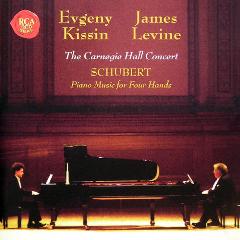Schubert - Piano Music for Four Hands (Kissin, Levine) [2005]
Schubert - Piano Music for Four Hands (Kissin, Levine) [2005]

DISC 01 01. Fantaisie D.940 02. Allegro D.947 'Lebensstürme' DISC 02 01. Schubert - Sonata In C-1 Piano 4 Hands 02. Schubert - Sonata In C-2 Piano 4 Hands Andante 03. Schubert - Sonata In C-3 Piano 4 Hands Scherzo & Trio Allegro Vivace 04. Schubert - Sonata In C-4 Piano 4 Hands Allegro Vivace 05. Schubert - Characteristic March #1 C D968B 06. Schubert - Military March #1 D D733 Evgeny Kissin (piano) James Levine (piano) rec. live, 1 May 2005, Carnegie Hall, New York City
Applause ripples through Carnegie Hall, and the music begins – just a little too soon. A moment or two more of that anticipatory atmosphere would have done no harm on a 34 minute disc. Never mind, the magic spell of Schubert’s D940 Fantasie is one which has held me for a long time, and Murray Perahia and Radu Lupu’s 1985 recording has been a ‘Desert Island Disc’ for almost as long as I can remember – something which has more to do with my drinking habits than my age. Perahia and Lupu perform the work as intended, on one piano. Kissin and Levine have the luxury of a piano each, and the booklet amusingly gives one of the reasons for this as giving ‘a certain degree of comfort.’ “They couldn’t fit behind one keyboard!” my mate Johan the piano guffawed, but not so: I have seen a broadcast with Levine playing two pianos, eight hands - a good trick if you can do it - and admiring his economical performing style and apparently effortless technique. The two pianos in this recording do make quite a difference to the music however. Normally one player would control the sustaining pedal, but now of course there are two completely independent pedals. The climaxes are also far more orchestral in effect, with the extra dynamic of two pianos providing much more of a kick, and with the two players separated left and right, there is also a greater definition of each part. Listening carefully, one wonders sometimes how two players sitting next to each other at one keyboard ever manage it, such is the fullness of each part on occasion.
I must admit to liking this approach. It supplements an understanding of this wonderful piece in so many ways, and Kissin and Levine are on top form. The performance is a little brisker [18:45] than Perahia/Lupu [19:18] and possibly a little less poetic, certainly less intimate – but this is what you would expect from a live performance in such a space. The drama of the moments just before the final, tragic coda are monumental, and almost worth the price of this disc on their own.
The Allegro D947 is another rave performance of a superb piece. The opening hits like the slap of an Atlantic wave, and fully justifies the over-used ‘orchestral’ description. The subsequent counterpoint, rolling accompaniments and melodic phrases are a joy to behold, full of lightness and contrast of touch. Schubert’s bitter-sweet harmonic changes have rarely sounded so affecting to me: Kissin and Levine know exactly when to pull the listener forward in his seat, carrying the sometimes startling changes forward sotto voce, ready to apply the full g-force when required.
The second CD begins with the ‘Grand Duo’ D812, which I know can be summed up by the phrase ‘it goes on a bit’ - I can hear my father saying it now - but like many such marathon masterpieces it has to be listened to properly to extract all of the Schubertian goodness within. The piece was written while staying at the Esterházy estate, away from Vienna, after a period of illness in which Schubert was confronted with periods of depression and despair. Schumann was for a long time convinced that the work was an arrangement of a symphony, describing some of the orchestrations as he heard them. The piece has indeed been given a number of orchestral arrangements, and benefits greatly from the colourful setting provided by Kissin and Levine. The only possible argument against the grand scale of this two piano performance is that it elbows its way out of Schubert’s traditional environment; the intimate setting of the private household. This may be true, but the remarkable nature of so much of Schubert’s chamber music was always destined to be recognised outside restricted circles of friends and admirers. Presented with such a joyous and refined recording I can’t imagine him rending his garments in distress!
After the long but satisfying sit of the Sonata in C, there are the welcome after-dinner sweets of two marches: the energetic D968b, and the amusing Military March No.1, which has a Gottschalk swing to it which closes this concert in cracking style. I can imagine the buskers outside Carnegie Hall doing very well that evening, with the audience leaving in high spirits.
This is a superb issue. The recording is outstanding, and the audience extremely well behaved, with hardly any coughing and no troublesome bumps or crashes. The Grand Piano Sound fills Carnegie Hall completely. The energy and spirit of these live performances have that quality of uniqueness which means they can take pride of place alongside any studio recording one can name – not necessarily replacing them, but often more likely to be chosen for a spin if the truth be known. ---Dominy Clements, musicweb-international.com
download (mp3 @320 kbs):
yandex 4shared mega mediafire uloz.to cloudmailru uptobox ge.tt








